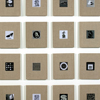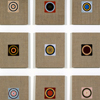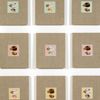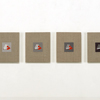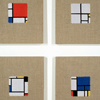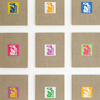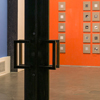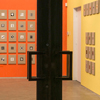Pattern Recognition. 2006-07 Click on images to view project. |
 |
||||||||
 |
||||||||
Pattern Recognition has three parts. The first consists of two handmade embroideries, one of which reproduces a detail of Henri Matisse’s 1948 painting Interior with an Egyptian Curtain. The artist derived the pattern of the curtain from a hanging in his large collection of tapestries; my embroidery restores that pattern to its textile origins. The other handmade embroidery is a portrait of Matisse, based on a black-and-white photograph of the artist in his studio with color swatches for his late works tacked up on the wall behind him. The second part of the project is a group of embroideries made on a computer-programmed sewing machine, modeled after the pinked fabric swatches long used in the textile industry. They are reproductions of paintings by more than twenty well-known modern and contemporary artists, including Arthur Dove, Ellen Gallagher, Philip Guston, Damien Hirst, René Magritte, Henri Matisse, Piet Mondrian, Ed Ruscha, Nancy Spero, Kara Walker, and Andy Warhol. These embroideries are grouped by artist into combinations of two to nine units. Some of the groupings reproduce a signature work in several variations while others comprise distinct works that play off a similar motif. Densely stitched emblems of uniform size and shape, these embroideries employ a hypermodern combination of mechanical and digital production to return the artworks on which they are based to much earlier fabric-based traditions of pattern and design. The smooth, continuous surface created by the digital sewing machine resembles that of a painting, while the hand-embroidered works, like images on a computer screen, are constituted of countless pixel-like stitches. The final component of the project is a swatch book—a set of the digital embroideries bound into a sample book like those commonly used in the textile industry. Here, the artworks are reproduced in tints of cyan, magenta, and yellow, a complement to the blacks and grays of Swatches, B&W 1–25. Both pieces emphasize the links between digital embroidery and printing by making specific reference to the CMYK color print standard. |





